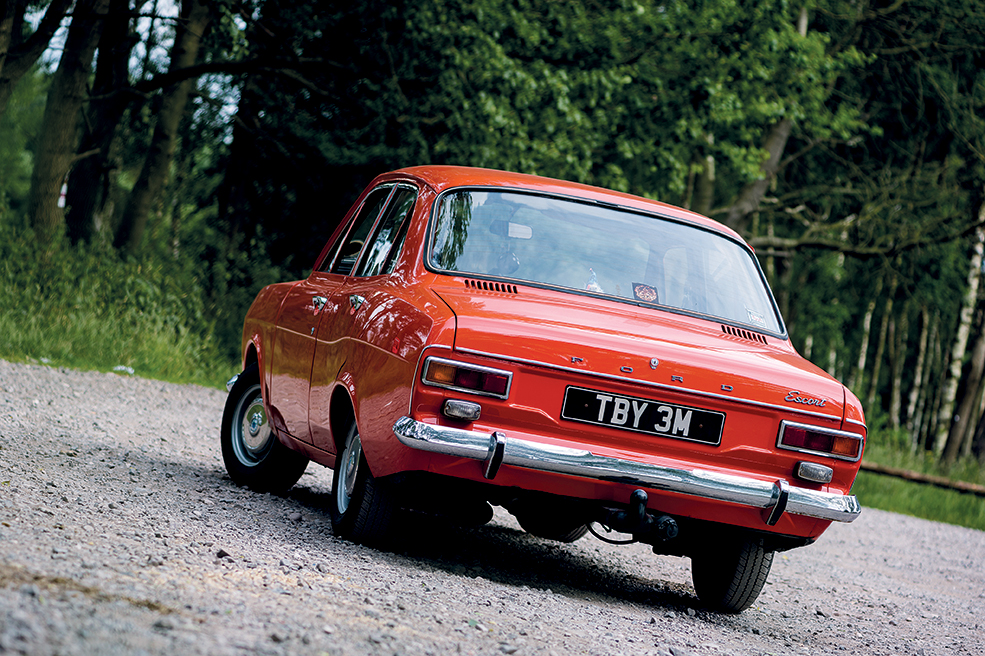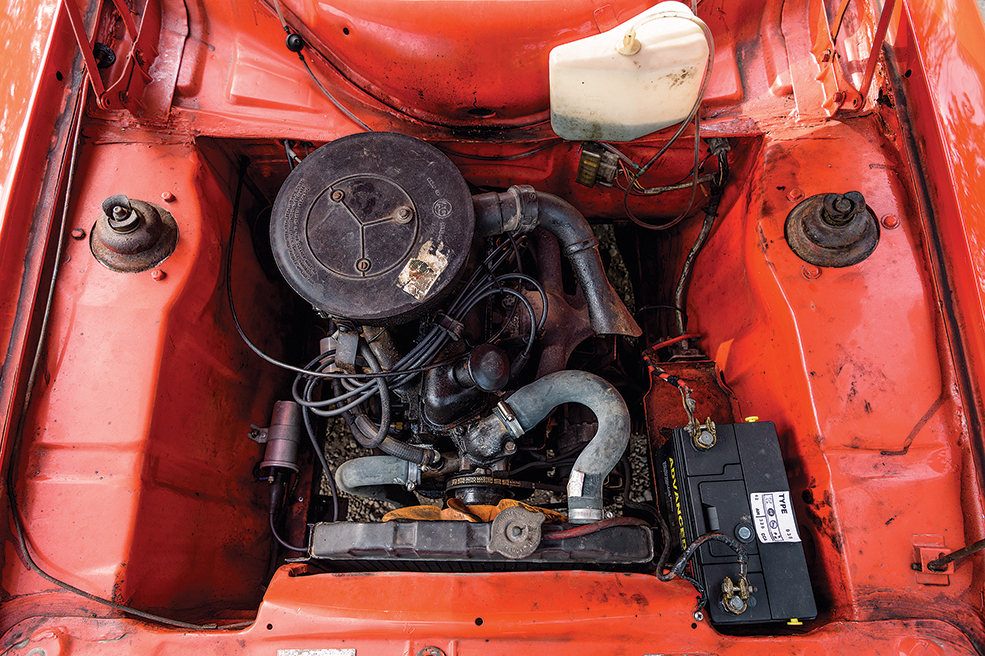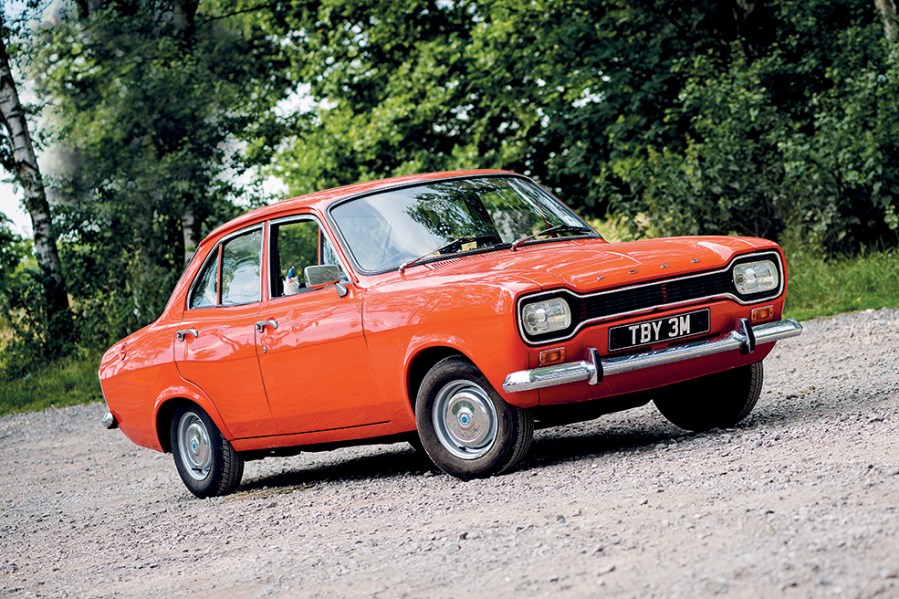Prices may have gone through the roof in recent years but the Ford Escort Mk1 or Mk2 is still a great classic choice. Here’s what to look for
Words: Iain Wakefield
By the mid-1960s, a pan-European programme involving Ford’s still independent research centres in the UK and Germany to replace the 105E Anglia was starting to gather pace. Although Ford’s then Birmingham-based research centre had explored a front-wheel drive set-up, along with a rear engine, a decision was made to produce the new car around the outgoing model’s rear-wheel drive format and opt for a MacPherson strut front suspension layout instead of anything too radical.
The decision not to adopt a more adventurous drivetrain had obviously disappointed the Cologne based team following the introduction of their innovative front-wheel drive Taunus. However, Ford’s German development team was busy working on several other projects, so the bulk of the work developing the Anglia’s replacement fell on Ford’s UK-based design studios.
Lead designer for project ‘New Anglia’ was the noted stylist Harris Mann and the team’s target was to produce a small car to beat Vauxhall’s Viva. By the time Ford of Europe was formed in June 1967, development of the new Escort was well underway and the German team only became seriously involved with a few late changes and the addition of the four-door version to the range.
Ford of Europe unveiled the Escort to the public gaze in January 1968 at the Brussels Motor Show and the all-new model became an instant success. Advertised as ‘The small car that isn’t’, the OHV Kent powered 1100 Super had a price tag of £666, while the twin-choke Weber-fuelled 1300GT showcased the Escort’s sporting pretentions.
A three-door estate arrived three months later and a practical four-door variant of the popular Escort was introduced to the range the following year. The 1558cc Lotus powered Twin-Cam was first of the hairy chested Escorts, featuring a reinforced two-door bodyshell and this rare model is now both extremely desirable and equally expensive.

Another Escort featuring flared arches to emulate those of the Twin-Cam was the much cheaper 1298cc Crossflow-powered Sport and in 1970 the 16-valve, 120bhp Cosworth BDA (Belt Drive, A Series) powered RS1600 – RS standing for Rallye Sport – broke cover. To commemorate that year’s London-Mexico rally, Ford unleashed the 1599cc Crossflow-powered Escort Mexico, a model that over the years has been extensively cloned.
Hot Escorts continued to clock up regular rally and race wins throughout the early 1970s. The now highly desirable (and expensive) 2-litre Pinto-powered Escort RS2000 was created by Ford’s Advanced Vehicle Operations (AVO) and released for limited public consumption in July 1973.
Ford produced the Mk1 version of the Escort, including the up-market 1300E, until the heavily revised Mk2 took over the reins in late 1974. Developed under the code name Brenda, the second incarnation of what was fast becoming the nation’s favourite car now featured a totally different profile.
Out went the early car’s subtle curves and in came a sharp, squared-off body shape sitting on a revised underbody that had been used for the last six months of Mk1 production. A full-sized black-painted front grille now replaced the earlier car’s ‘dog bone’ affair and entry level Mk2s were badged as the starkly equipped Popular.
There was still no hatchback in the range, although a four-door estate was available. Mainstream models now included L and GL-badged variants, while the Ghia badge took over from the ‘E’ suffix on the range-topping non-sporting models. Although the mechanical line-up was very much as before, the good news was that there was now a 1599cc 1.6-litre unit available for mainstream models.
As with the Mk1, Ford produced an impressive range of sporting Mk2 Escorts and these included the Sport, RS1800, RS Mexico and RS2000. The 1.3 and 1.6-litre Sport models had replaced the Mk1 GT and the DOHC RS1800 was another Escort ‘homologation special’ produced to allow the Mk2 to go racing.
The 1593cc SOHC Pinto-powered Mk2 Mexico was the ultimate ‘boy racer’, although it was successful overshadowed by the very capable Escort RS2000. Powered by a 1993cc version of the Pinto engine, the RS2000 was rated as a great driver’s car and was instantly recognised by its plastic wedge-shaped nose cone and quad headlight set up.
From late 1978 a cheaper variant of the RS2000 equipped with steel wheels took over from where the Mexico left off and Mk2 production finally came to an end with the introduction of the heavily revised Mk3 hatchback range in 1980. Following is what to look for when viewing either a Mk1 or Mk2 Escort, whether it’s a very expensive sporting model or a more affordable cooking version.
Bodywork
The Mk1’s bodywork was quite an advanced structure for the time. Each complete side of the two-door model was stamped out as a single panel, which means that door gaps were very tight and even all the way around the opening. A poor fitting door is a good giveaway for any poor-quality accident repairs.
Not many Escorts – Mk1 or Mk2 – will have escaped an occasional touch from the welding torch, as rust will no doubt have attacked some areas on even the best-maintained examples. Corrosion hotspots are the front inner wings, suspension top mountings, front and rear of the outer wings, bonnet mountings, floorpans, door bottoms, sills, boot floor, both valences and all the wheelarches.
Rust will also seriously weaken the suspension mountings if left unattended and the base of the windscreen can also corrode badly. Water leaks are not uncommon, so lift all the carpets and check the condition of the floors and bulkheads for any signs of damp. Tracing any missing exterior trim will be difficult on both marks and restoring seriously pitted chrome plated Mazak trim is virtually impossible.

Engine and transmission
The Mk1 Escort was powered by a decent range of engines, with mainstream models receiving either a 1098cc or 1298cc Kent OHV inline-four. These are easy units to work on and parts supply is reasonably good through club contacts and marque specialists. The Mk2 received a power boost with the inclusion of a much-needed 1.6-litre power unit and all these engines are reasonably long lasting providing they’ve been serviced correctly.
When it comes to the Pinto engine fitted to some of the sporting models, these are equally straightforward to inspect and work on, but any hammering from the top of the engine will indicate a worn camshaft. A common problem with these engines was a blockage in the oil feed tube along the cam rail and if the oil hadn’t been changed regularly, or the incorrect grade was used, the camshaft suffered.
The Pinto engine has a cam belt, so enquire if it’s been replaced recently and budget for the cost of the work if this reasonably straightforward DIY job hasn’t been done recently. Twin-cam engines are far more complex to overhaul and any work on these units should really be left to an expert. Kent engines on the other hand can also suffer from noisy tappets but this is generally down to worn cam followers.
When inspecting the power unit, pay particular attention to the condition of the coolant in the header tank. Any oily scum floating on the surface could indicate a failed head gasket is just around the corner. Blue smoke exiting the exhaust will indicate worn bores and/or piston rings, although oil could be being drawn down the valve stems on high-mileage motors.
A worn out Autolite carb on some of the non-sporting models will cause the engine to run rough – a Weber conversion kit is a worthwhile conversion if that’s the case – and don’t worry too much about the odd oil leak. The Crossflow and Pinto engines can leak from the rocker cover and it’s not uncommon for oil to drip from the front and rear crank seals as well.
Several different types of four-speed manual gearbox were fitted to the Escort, with sporting versions receiving a close-ratio box. Any ominous rumblings when in the first three ratios will indicate worn or tired bearings, although these can go on grumbling away for years before any action is required. Jumping out of gear, especially on the overrun, is a sign that the box is well overdue an overhaul.
Don’t forget to test the clutch on manual cars and locate where the biting point is. Fitting a new clutch assembly isn’t the end of the world, as the gearbox can be taken out from underneath the car. As the Kent engine doesn’t produce a huge amount of torque, an auto box can go for years but always check the condition of the fluid – it should be bright red and changes should be smooth, with no jerking on take-off or while swapping ratios.

Suspension, steering and brakes
The steering rack fitted to both the Mk1 and Mk2 rarely gives any trouble but check the condition of the rubber gaiters – any splits will let in road grit, which will lead to rapid wear. Any clonks from the front suspension may be down to a worn anti-roll bar or a broken front coil spring.
Front MacPherson struts can leak and are easily replaced but make sure you know how to compress the road spring safely. Rear leaf springs can soldier on for decades but the dampers may require changing if the rear end feels soggy. Rear wheel bearings can get noisy as the mileage mounts up but these are pressed on and replacement is definitely a workshop job.
When it comes to the braking system, a lot of Escorts were fitted with drums all round. Quite a few of the better-equipped variants, along with all the sporting models featured front discs.
The only issues to check for in this department are the condition of the discs and/or drums and look out for any leaking wheel cylinders or corroded brake lines. While checking out the braking system, make sure the handbrake holds the car on an incline and the ratchet holds the lever securely.

Interior and trim
Vinyl trim was not only a standard fit on the poorly-equipped base models, but was also found on the Sport, XL, Super and Mexico, while GL, RS and E badged models were fitted with cloth seat facings. Both materials are reasonably hard-wearing and quite a few patterns and styles are still available from specialist suppliers. Employing the services of a professional trimmer will easily revive the look of a tired interior on one of these cars.
Sourcing replacement hard trim can be difficult, but quite a few repro parts are available and clubs can be a great source for tracking down second-hand trim. One really tricky part to find is the Mexico’s sculptured rear seat and this is a good indicator of whether the car is the genuine item or just a tarted-up two-door base model.
Although the Escort’s electrical system is a very simple set-up, poor earths and corroded contacts will take time to locate and fix. Bodged or untidy extra wiring, especially around the fusebox area, can be nightmare to sort but if the loom is in a really poor state, specialist suppliers can supply a model-specific replacement.
There’s not too much equipment inside the Escort’s cabin to check, but it should all ideally work and don’t forget that the horn is located on the end of the indicator stalk!
Ford Escort Mk1 & Mk2: our verdict
Buying a sporting Escort can be a minefield for the uninitiated. Dressed up imposters sold as the real thing isn’t uncommon, so a pre-purchase check by someone from the relevant club is really necessary to avoid being conned. On the other hand, it’s fine if the car is being advertised as a replica and this can be a bargain way of getting into ‘hot’ AVO Escort ownership.
However, a lot of two-door Escorts have been stolen to produce a Mexico or RS model, so double-check all the paperwork is in order and walk away from the deal if in any doubt. Two-door L or XL-badged Escorts are still thankfully reasonably affordable.
If you want to enjoy a good-driving slice of 60s or 70s saloon-car motoring and like the idea of your classic holding it value or even appreciating over time, the Escort remains a great choice.


















